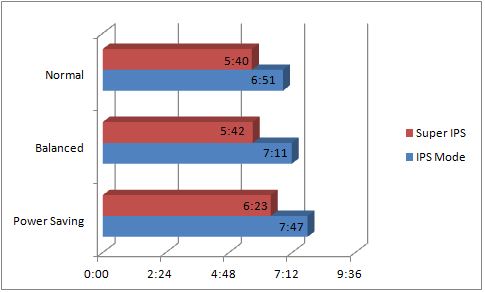ASUS Eee Pad Transformer Prime Power Modes Tested: Which Gets the Most Battery Life?

Among its other attributes, the ASUS Eee Pad Transformer Prime has two unique features that will help users extend its battery life: The ability to switch the screen from Super IPS+ to Standard IPS mode, and three performance settings: Power Saving, Balanced, and Normal. But how much more battery life can you squeeze out of the Prime?
First, an explainer. In Standard IPS mode, the Transformer Prime maxes out at an extremely bright 380 nits, but when you enable Super IPS+ mode, that number jumps to 600 nits.
For the performance settings, in Normal mode, all four of the Tegra 3 CPU's cores can operate at their maximum speed of 1.3 GHz; in Balanced mode the cores are capped at 1.2 GHz. Power Saving mode caps the cores at 600 MHz when all four are active, 700 MHz when three are active, and 1 GHz when one or two are active. It also caps the frame rate at 35 fps and lowers the display power.
So, with two brightness settings and three performance settings, that's six possible permutations. And we've tested them all.

To test the Transformer Prime, we used our standard LAPTOP Battery Test, continuous web surfing via Wi-Fi with the screen brightness at 40 percent. Also, these tests were conducted with the tablet alone, and not when connected to its dock.
As was expected, the combination of Power Saving and IPS gets you the longest runtime, while Super IPS and Normal eats up the battery the fastest. However, we were a little surprised that there was almost no difference between Normal and Balanced mode when using Super IPS mode. As ASUS said, most users will see the best combination of power and endurance using Balanced mode.
Stay tuned for our battery tests of the Prime using its keyboard dock.
Stay in the know with Laptop Mag
Get our in-depth reviews, helpful tips, great deals, and the biggest news stories delivered to your inbox.
Michael was the Reviews Editor at Laptop Mag. During his tenure at Laptop Mag, Michael reviewed some of the best laptops at the time, including notebooks from brands like Acer, Apple, Dell, Lenovo, and Asus. He wrote in-depth, hands-on guides about laptops that defined the world of tech, but he also stepped outside of the laptop world to talk about phones and wearables. He is now the U.S. Editor-in-Chief at our sister site Tom's Guide, where he oversees all evergreen content and the Homes, Smart Home, and Fitness/Wearables categories for the site..
